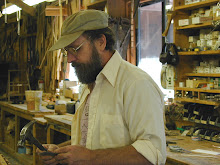After the chemical has done its job the boat is moved outside to the other tray where it is power-washed and scrubbed with fresh water to remove any chemical residue. The run off from this tray is captured and pumped into a second tank where the water is heated to evaporate the residue chemical.
This is what it looks like working at the first stripping tray. Heavy rubber gloves, a chemical suit,and a face respirator that has a fresh air hose are all needed for protection from the caustic stripper chemical. Here I am scrubbing out the inside of a 16 ft Old Town Sea Boat. All the interior bracing, seats and deck have been removed to allow access for the stripping. Its physical difficult and completely unpleasant job that we swear we will never do again but somehow end up doing again every year!




5 comments:
Sandblast with nut shells? The boats your working on are old and the cedar soft. But I think if you stay away from the cedar with the blasting nut shell gun you could do a nice job.. I might be worth looking into.
http://www.kramerindustriesonline.com/blasting-media/corn-cob.htm
Corn for sandblasting
Build a plastic tent so you can re use the corn.
Did you use silicon carbide grit when you were doing this project? I want to do something like this with an old boat of mine, and I'm wondering what the best materials would be to do it with. I've heard that the grit is a good choice. Suggestions?
I'm going to try soda blasting instead of corn cob. I have a "Huron Village" canoe that's a family heirloom and my Dad would kill me if I damaged it.
Post a Comment